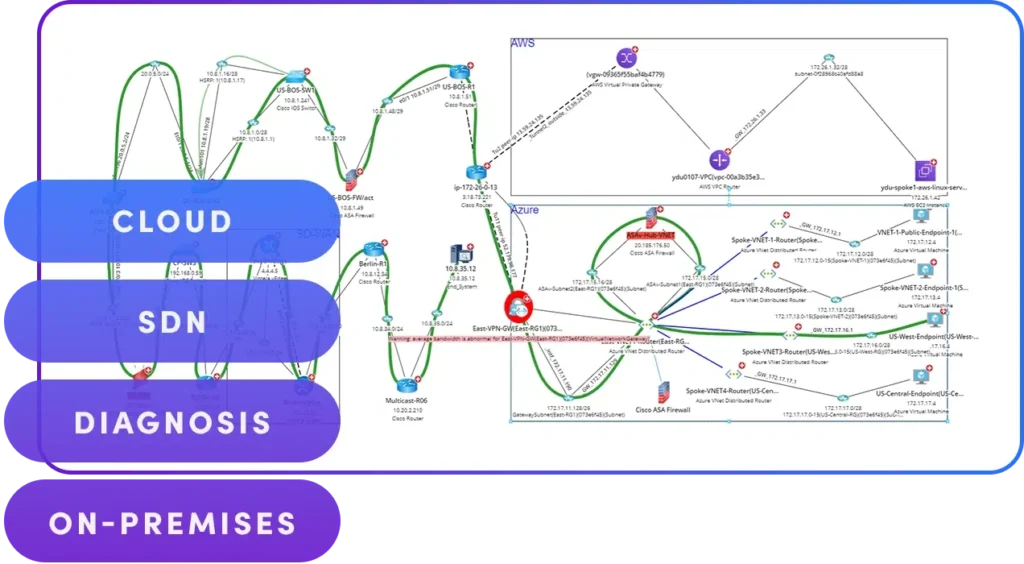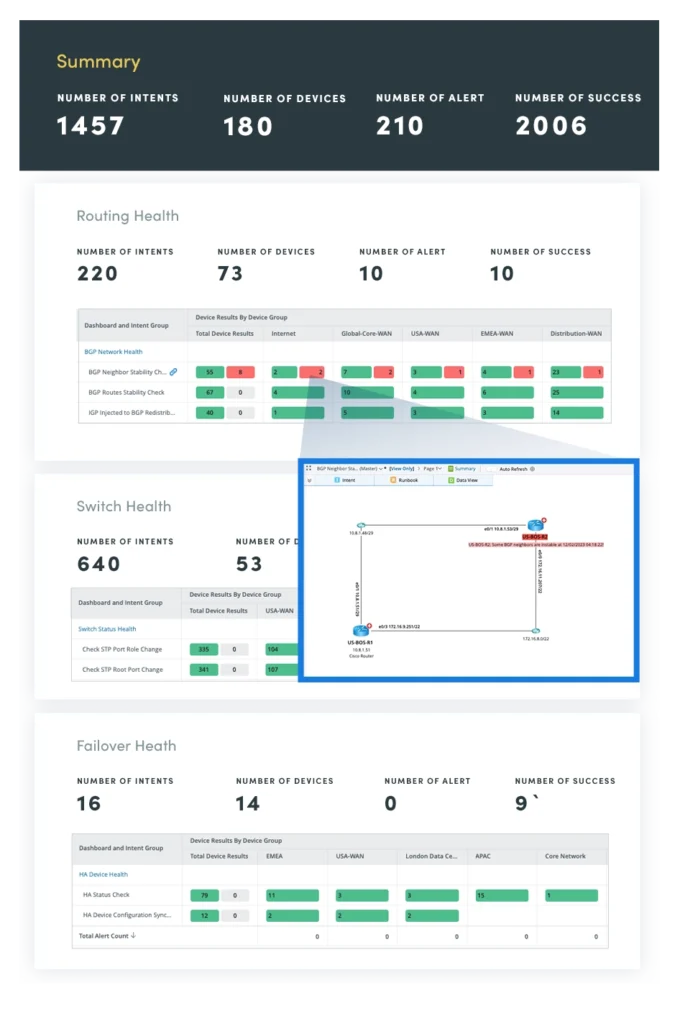What Happens After BGP?
Gaining Full Path Visibility in Hybrid Cloud Networks In the modern enterprise, Border Gateway Protocol (BGP) plays a foundational role in connecting distributed networks. It is the routing protocol that...
Join us at NetBrain LIVE 2025 – Learn, Connect, Grow!
by Valerie DiMartino Jun 6, 2024
Modern enterprise networks are increasingly hybrid, distributed, and dynamic, making them difficult to manage using static diagrams or isolated monitoring tools. Network visualization provides a real-time, topology-aware view of the infrastructure, offering deep insight into device relationships, traffic flow, and policy enforcement across physical, virtual, and cloud environments.
Visualization enables network teams to accelerate troubleshooting, optimize resource allocation, and improve operational efficiency across complex environments by surfacing the data that matters in context.
Network visualization, or visibility, is an understanding of the infrastructure and traffic flows in an organization’s hybrid network. The term also encompasses awareness of everything in and traversing through your hybrid network, as well as the use of visibility tools that enable this understanding.
Modern network visualization tools are used to enhance alertness and responsiveness for improved network monitoring and control over connections, application traffic, network performance, network resourcing, and data.

Network visualization enables IT teams to operate with greater speed, clarity, and control by combining complex network components into a unified view. This visualization gives teams a clear, real-time view of how bandwidth, devices, and connections are used across the environment so they can spot underused or overloaded resources, track capacity trends, and prioritize the right services. Management of network resources is critical for effective and scalable network management and planning for growth, supporting new and existing services, and network health.
Additionally, network visualization software allows you to exercise greater control for decision-making so you can better meet the needs of the business without disruption. It affords you the ability to proactively react to any issues that arise and to prepare network diagrams and documentation much more quickly and accurately for regulatory compliance audits.
Network visibility helps you plan for future growth, be less reactive in your operations, and have greater success with digital transformation projects, including cloud migration, by helping you scale your network to deliver IT services at the levels businesses require.
Network visualization provides a simplified view of network traffic and helps with resource utilization. This allows organizations to identify areas that have inefficiencies, potential security vulnerabilities, or need improvements. Below are more in-depth looks at the benefits of network visualization.
Effective network visualization is not a one-size-fits-all approach. Engineers rely on different visualization formats depending on the task at hand — whether it’s diagnosing an outage, analyzing performance trends, or maintaining compliance. Network maps, charts, graphs, and dashboards each offer unique perspectives that make it easier to interpret complex environments and take informed action.
Network maps provide a visual representation of the physical network topology, including infrastructure connections and relationships between devices. You can use either of the following:
Charts and performance graphs showcase key network metrics over specified time frames, allowing teams to easily identify trends, anomalies, or relationships between factors. Pie charts may break down traffic by device or protocol, while line graphs show bottleneck events. Meanwhile, graph network visualization helps identify trends and patterns that can impact network performance.
Dashboards aggregate visualizations like maps, charts, and key performance indicators onto a single screen. This unifies critical data for at-a-glance network health and activity monitoring from a centralized home base. Alarms on dashboard widgets ensure nothing falls through the cracks.
Network visualization proves invaluable during times of rapid expansion when it’s paramount to understand dependencies before changes occur. It also streamlines network troubleshooting by guiding engineers to the root causes of issues through real-time topological context. Whether optimizing existing systems or scaling to meet growth, network visualizer software allows you to proactively monitor your network, visualize and resolve issues, and plan for the future of your IT infrastructure.
Implementing network visualization effectively demands a disciplined, strategic approach. From understanding how devices interconnect to ensuring your visualization efforts support security and scalability, following proven best practices is essential. The right foundation improves daily operations and prepares your network to adapt as technologies and business needs evolve.
A thorough understanding of your network topology is crucial. Use dynamic network visualization tools for network topology mapping to stay up to date, as these maps reflect changes in real time.
Ensure your network visualization includes insights into network vulnerabilities. Regularly review and update your network security policies based on visualized data.
Choose network visualization tools that integrate seamlessly with your existing infrastructure. Tools that support interactive network visualization can enhance your ability to effectively manage and troubleshoot your network.
Automate network documentation processes to ensure accuracy and efficiency. Updated documentation aids in troubleshooting and capacity planning.
Use network visualization to identify trends and plan for future network expansion. This proactive approach can prevent bottlenecks and ensure your network can scale as needed.
Single-pane-of-glass promises complete end-to-end visibility across the IT environment, but it’s seldom achieved. Today’s networks span distributed data centers, hybrid multi-cloud environments, and internet-connected brand offices. Most tools cannot deliver full-path awareness — here’s why:
Network visualization often lacks real-time input from IT Service Management (ITSM), Network Performance Monitoring (NPM), and security platforms. It also lacks data to inform intent, performance, and operational decisions. Teams must manually correlate data from multiple sources, spend time switching between dashboards, and miss root causes buried in surrounding systems.
True single-pane-of-glass visibility:

While many suppliers claim to offer single pane of glass visibility, users rarely feel like they have this unified visibility due to disconnects between different parts of the network and the ecosystem of tools surrounding them. But customers of NetBrain have had this visibility for years and use it every day!
At NetBrain, we provide unified, single-pane-of-glass visibility across the entirety of your hybrid network infrastructure. By automatically discovering all network nodes and devices and leveraging ecosystem data to build a complete Digital Twin, NetBrain’s pane eliminates NetOps pain.
Schedule a demo to see how we can help your team achieve single-pane-of-glass visibility.
Gaining Full Path Visibility in Hybrid Cloud Networks In the modern enterprise, Border Gateway Protocol (BGP) plays a foundational role in connecting distributed networks. It is the routing protocol that...
Your Network Automation Is Holding You Back Network teams across industries are caught in an automation paradox. While 64% of enterprises rely on homegrown scripts and open-source tools like Ansible,...
NetBrain CEO Insights from ISMG Interview at RSAC How Agentic AI decodes network intent to automate diagnosis In the rapidly evolving world of IT infrastructure, preventing recurring network outages...
We use cookies to personalize content and understand your use of the website in order to improve user experience. By using our website you consent to all cookies in accordance with our privacy policy.